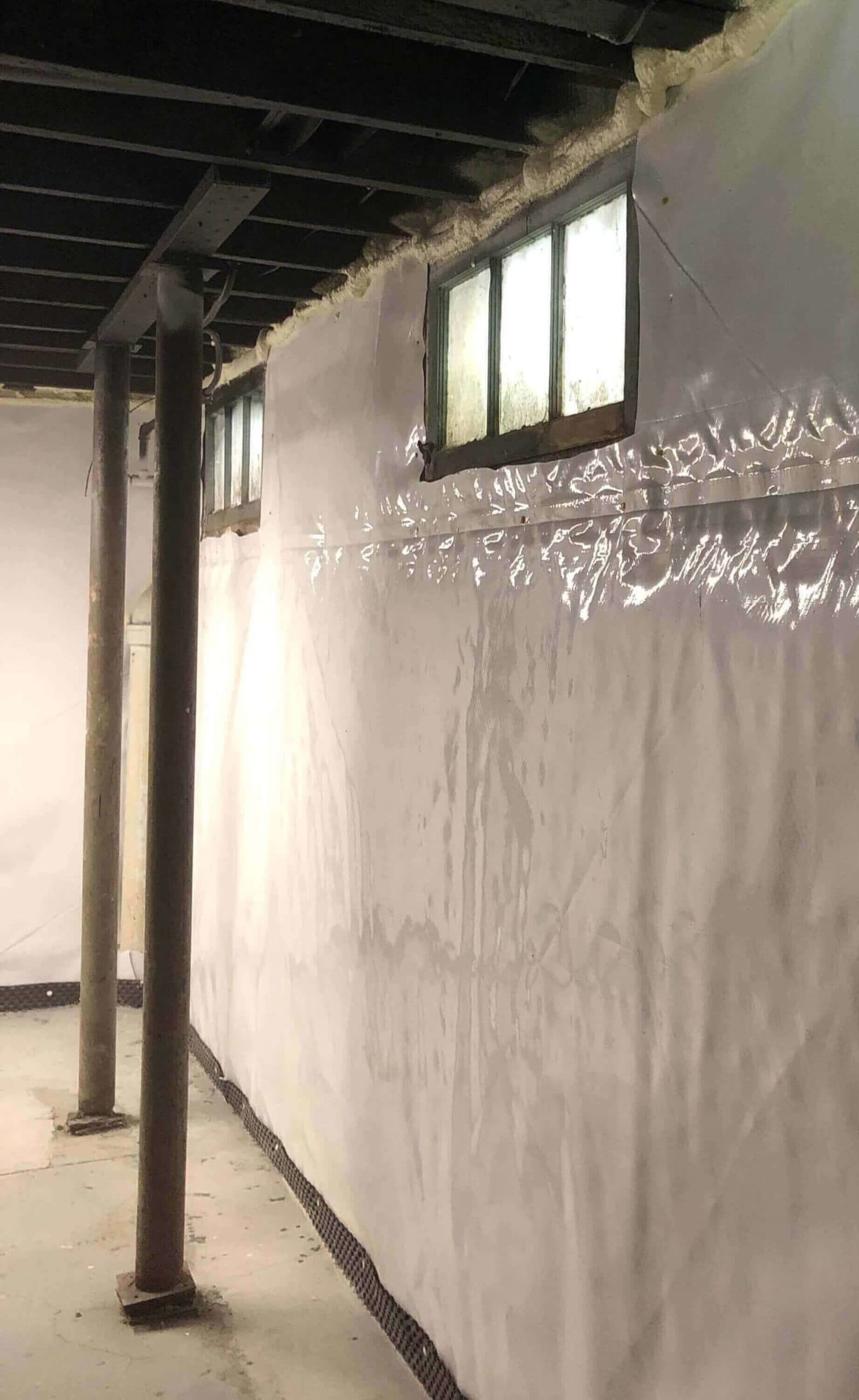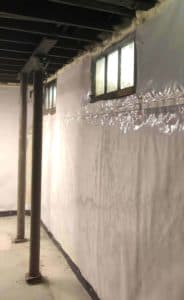The Best Way to Finish Your Basement: Start with Encapsulation

Originally posted 5/28/20, updated 11/26/20
When you go into your basement, what do you see? Is it a dark, slightly damp place you can’t use- not even for storage? A slightly creepy area where only your furnace and utilities live? Or maybe you see raw, untapped potential.
A basement can be a clean, dry, inviting area that extends your living space and adds property value to your home investment. All you need is the right framework.
Acculevel was founded in 1996 by Andy Beery and remains a family-owned and operated business.. We have waterproofed and encapsulated thousands of basements over the years. If you are interested in getting the most out of your basement, encapsulation plays an essential role.
Encapsulation is the process of covering basement walls with a thick plastic sheeting. It’s similar to installing a pool liner, except the function in this instance is to keep water out, not in. We’re going to explain why we recommend encapsulation, how it’s done, and what the necessary components are.
Why Do We Recommend Encapsulation?
We recommend encapsulation for two different sets of circumstances.
First, if you have an older home with a foundation made of brick or stone. These building materials are highly permeable and offer less resistance to water seepage (when compared to modern concrete or concrete block). Water can have a damaging effect on the mortar joints between bricks and stones, which increases the likelihood of water seepage. Water seepage leads to foundation decay, mold growth, and provides an ideal home for invasive pests like termites. We review the benefits to a waterproof basement in another blog.
Second, we strongly encourage encapsulation on the walls if you plan to fully finish your basement. Even when the water is draining into a drainage system, the foundation itself can become damp. That humidity can be enough to allow mold to develop in the insulation and spread to your drywall and wooden framing. No one wants to install a shiny new home theater in their basement, develop mold, only to have to tear a portion of it apart, clean up and start over.
Encapsulation Must Include Waterproofing
I mentioned needing the right framework earlier, and part of assembling this is installing a quality waterproofing system. Waterproofing requires two components: the water drainage channel that collects the water, and the sump pump that expels it from your basement.
The water drainage channel is installed under the basement floor; in the picture below, you can see a darker line of paving next to the wall. This is new concrete, freshly poured over the newly installed drainage.
 This picture was taken by an Acculevel crew member after the waterproofing installation was completed.
This picture was taken by an Acculevel crew member after the waterproofing installation was completed.
The sump pump is installed in a “sump pump pit,” which is a hard-to-say combination of words that describe a hole dug into the floor. The drainage channels are routed to drain into the pit, and when the water level reaches a certain point, the pump kicks on. The pump expels the water through a discharge line, which runs through the outside wall to discharge the water a safe distance from your house (a minimum of 10 feet).
Encapsulation Has Three Components
Dehumidifier: you will need to install a dehumidifier to control the humidity level in your basement. Condensation develops whenever there are temperature differences between the inside and outside of your foundation.
If this condensation collects on the encapsulation barrier, it will develop mold or mildew. This will then spread to your insulation and wood framing. If you would like more information about dehumidifiers and their uses, please check out our blog on this topic.
Spray Foam: this is a type of insulation that can be sprayed into cavities or gaps in between the basement walls and the “ceiling” that contains your wooden flooring structure.
Unlike older fiberglass insulation, the spray foam does not absorb moisture. It helps maintain the seal of the whitecap, without giving humidity anywhere to go (except down into the drainage channel).
Additionally, spray foam insulation helps guard against air drafts. Your floors will stay warmer on the home’s main level and keep your basement warmer. This provides comfort- and should help with your heating and cooling bills, too.
 This picture was taken by an Acculevel crew member during encapsulation. White cap is being applied to the basement wall, and sealed against the ceiling with spray foam.
This picture was taken by an Acculevel crew member during encapsulation. White cap is being applied to the basement wall, and sealed against the ceiling with spray foam.
White Cap: A white cap barrier is a heavy plastic sheeting that is attached to the basement walls. This is not a flimsy material, like some heavy-duty version of plastic wrap. The encapsulation material that Acculevel installs is a polyurethane membrane interlaced with high-density fibers. This white cap is the strongest and most puncture-resistant on the market.
This wall liner is not glued to the walls like a wallpaper. The only exception is the limited number of locations where it is tacked in place (and sealed at the top with spray foam). The purpose of this “floating” installation is to create a very narrow gap between the white cap and the wall.
That minuscule gap is enough to allow water to seep down between the white cap and the wall, into the drainage channel. And because this encapsulation material is an inorganic wall liner, it will not support mold.
Additional Resources
Would you like more details about basement waterproofing? You can find our complete guide and related topics here.
If you have not hired a contractor before and would like some guidance on how to proceed, we offer a checklist of questions you should ask.
Have concerns in addition to a damp basement and encapsulation? We have a free tool that allows you to check for causes and symptoms.
Want to Know More About Your Options?
If so, then you need to find an experienced local waterproofing company, and make an appointment. Before you sign a contract for any service, you should always verify the company is reputable, insured, and accredited by the Better Business Bureau.
If you live in Indiana or the surrounding states, contact Acculevel for a free estimate. An experienced project manager will evaluate your home and recommend the best course of action for you, to keep your home strong and healthy for years to come.